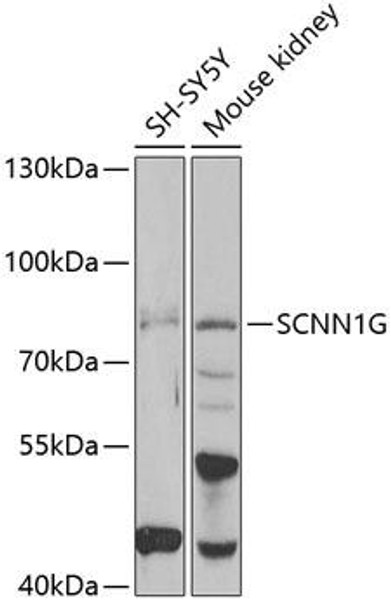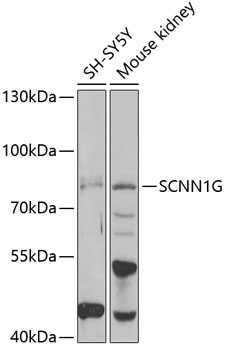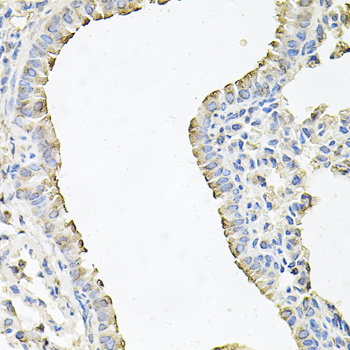Anti-SCNN1G Antibody (CAB6126)
- SKU:
- CAB6126
- Product type:
- Antibody
- Reactivity:
- Human
- Reactivity:
- Mouse
- Host Species:
- Rabbit
- Isotype:
- IgG
- Antibody Type:
- Polyclonal Antibody
- Research Area:
- Signal Transduction
Description
| 抗体名: | Anti-SCNN1G Antibody |
| 抗体コード: | CAB6126 |
| 抗体サイズ: | 20uL, 50uL, 100uL |
| 申し込み: | WB IHC |
| 反応性: | Human, Mouse |
| 宿主種: | Rabbit |
| 免疫原: | Recombinant fusion protein containing a sequence corresponding to amino acids 85-355 of human SCNN1G (NP_001030.2). |
| 申し込み: | WB IHC |
| 推奨希釈: | WB 1:500 - 1:1000 IHC 1:50 - 1:100 |
| 反応性: | Human, Mouse |
| ポジティブサンプル: | SH-SY5Y, Mouse kidney |
| 免疫原: | Recombinant fusion protein containing a sequence corresponding to amino acids 85-355 of human SCNN1G (NP_001030.2). |
| 精製方法: | Affinity purification |
| ストレージバッファ: | Store at -20'C. Avoid freeze / thaw cycles. Buffer: PBS with 0.02% sodium azide, 50% glycerol, pH7.3. |
| アイソタイプ: | IgG |
| 順序: | IKVH FRKL DFPA VTIC NINP YKYS TVRH LLAD LEQE TREA LKSL YGFP ESRK RREA ESWN SVSE GKQP RFSH RIPL LIFD QDEK GKAR DFFT GRKR KVGG SIIH KASN VMHI ESKQ VVGF QLCS NDTS DCAT YTFS SGIN AIQE WYKL HYMN IMAQ VPLE KKIN MSYS AEEL LVTC FFDG VSCD ARNF TLFH HPMH GNCY TFNN RENE TILS TSMG GSEY GLQV ILYI NEEE YNPF LVSS TGAK VIIH RQDE YPFV EDVG TEIE TAMV TSI |
| 遺伝子ID: | 6340 |
| Uniprot: | P51170 |
| セルラーロケーション: | Apical cell membrane, Multi-pass membrane protein |
| 計算された分子量: | 74kDa |
| 観察された分子量: | 80kDa |
| 同義語: | SCNN1G, BESC3, ENaCg, ENaCgamma, PHA1, SCNEG |
| バックグラウンド: | Nonvoltage-gated, amiloride-sensitive, sodium channels control fluid and electrolyte transport across epithelia in many organs. These channels are heteromeric complexes consisting of 3 subunits: alpha, beta, and gamma. This gene encodes the gamma subunit, and mutations in this gene have been associated with Liddle syndrome. |
| UniProt Protein Function: | ENaC-gamma: Sodium permeable non-voltage-sensitive ion channel inhibited by the diuretic amiloride. Mediates the electrodiffusion of the luminal sodium (and water, which follows osmotically) through the apical membrane of epithelial cells. Controls the reabsorption of sodium in kidney, colon, lung and sweat glands. Also plays a role in taste perception. Defects in SCNN1G are a cause of Liddle syndrome (LIDDS). It is an autosomal dominant disorder characterized by pseudoaldosteronism and hypertension associated with hypokalemic alkalosis. The disease is caused by constitutive activation of the renal epithelial sodium channel. Defects in SCNN1G are the cause of bronchiectasis with or without elevated sweat chloride type 3 (BESC3). A debilitating respiratory disease characterized by chronic, abnormal dilatation of the bronchi and other cystic fibrosis-like symptoms in the absence of known causes of bronchiectasis (cystic fibrosis, autoimmune diseases, ciliary dyskinesia, common variable immunodeficiency, foreign body obstruction). Clinical features include sub-normal lung function, sinopulmonary infections, chronic productive cough, excessive sputum production, and elevated sweat chloride in some cases. Belongs to the amiloride-sensitive sodium channel (TC 1.A.6) family. SCNN1G subfamily. |
| UniProt Protein Details: | Protein type:Membrane protein, integral; Transporter, ion channel; Membrane protein, multi-pass; Channel, sodium Chromosomal Location of Human Ortholog: 16p12 Cellular Component: apical plasma membrane; external side of plasma membrane; integral to plasma membrane; plasma membrane Molecular Function:amiloride-sensitive sodium channel activity; ion channel activity; protein binding; sodium channel activity; WW domain binding Biological Process: excretion; multicellular organismal water homeostasis; response to stimulus; sensory perception of taste; sodium ion homeostasis; sodium ion transport; transmembrane transport Disease: Bronchiectasis With Or Without Elevated Sweat Chloride 3; Liddle Syndrome; Pseudohypoaldosteronism, Type I, Autosomal Recessive |
| NCBI Summary: | Nonvoltage-gated, amiloride-sensitive, sodium channels control fluid and electrolyte transport across epithelia in many organs. These channels are heteromeric complexes consisting of 3 subunits: alpha, beta, and gamma. This gene encodes the gamma subunit, and mutations in this gene have been associated with Liddle syndrome. [provided by RefSeq, Apr 2009] |
| UniProt Code: | P51170 |
| NCBI GenInfo Identifier: | 108885072 |
| NCBI Gene ID: | 6340 |
| NCBI Accession: | P51170.4 |
| UniProt Secondary Accession: | P51170,P78437, Q6PCC2, Q93023, Q93024, Q93025, Q93026 Q93027, Q96TD2, |
| UniProt Related Accession: | P51170 |
| Molecular Weight: | 74,270 Da |
| NCBI Full Name: | Amiloride-sensitive sodium channel subunit gamma |
| NCBI Synonym Full Names: | sodium channel epithelial 1 gamma subunit |
| NCBI Official Symbol: | SCNN1G |
| NCBI Official Synonym Symbols: | PHA1; BESC3; ENaCg; SCNEG; ENaCgamma |
| NCBI Protein Information: | amiloride-sensitive sodium channel subunit gamma |
| UniProt Protein Name: | Amiloride-sensitive sodium channel subunit gamma |
| UniProt Synonym Protein Names: | Epithelial Na(+) channel subunit gamma; ENaCG; Gamma-ENaC; Gamma-NaCH; Nonvoltage-gated sodium channel 1 subunit gamma; SCNEG |
| Protein Family: | Amiloride-sensitive sodium channel |
| UniProt Gene Name: | SCNN1G |
| UniProt Entry Name: | SCNNG_HUMAN |



